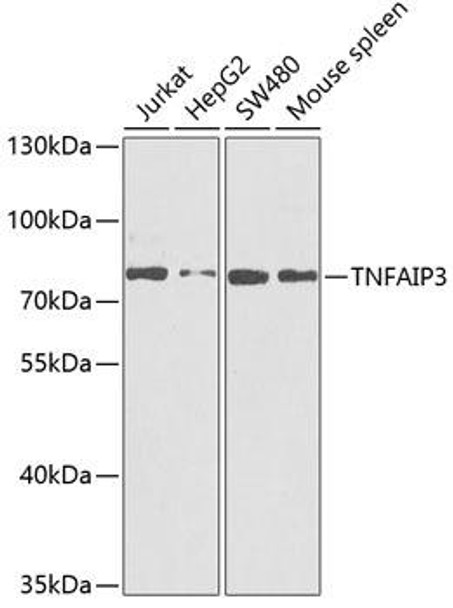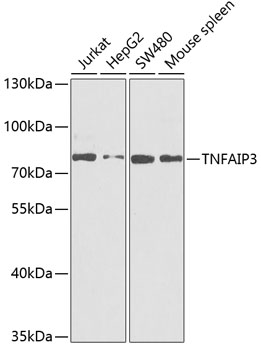Anti-TNFAIP3 Antibody (CAB2127)
- SKU:
- CAB2127
- Product type:
- Antibody
- Reactivity:
- Human
- Reactivity:
- Mouse
- Host Species:
- Rabbit
- Isotype:
- IgG
- Research Area:
- Cell Death
Description
| 抗体名: | Anti-TNFAIP3 Antibody |
| 抗体コード: | CAB2127 |
| 抗体サイズ: | 20uL, 50uL, 100uL |
| 申し込み: | WB |
| 反応性: | Human, Mouse |
| 宿主種: | Rabbit |
| 免疫原: | Recombinant fusion protein containing a sequence corresponding to amino acids 1-190 of human TNFAIP3 (NP_006281.1). |
| 申し込み: | WB |
| 推奨希釈: | WB 1:500 - 1:2000 |
| 反応性: | Human, Mouse |
| ポジティブサンプル: | Jurkat, HepG2, SW480, Mouse spleen |
| 免疫原: | Recombinant fusion protein containing a sequence corresponding to amino acids 1-190 of human TNFAIP3 (NP_006281.1). |
| 精製方法: | Affinity purification |
| ストレージバッファ: | Store at -20'C. Avoid freeze / thaw cycles. Buffer: PBS with 0.02% sodium azide, 50% glycerol, pH7.3. |
| アイソタイプ: | IgG |
| 順序: | MAEQ VLPQ ALYL SNMR KAVK IRER TPED IFKP TNGI IHHF KTMH RYTL EMFR TCQF CPQF REII HKAL IDRN IQAT LESQ KKLN WCRE VRKL VALK TNGD GNCL MHAT SQYM WGVQ DTDL VLRK ALFS TLKE TDTR NFKF RWQL ESLK SQEF VETG LCYD TRNW NDEW DNLI KMAS TDTP MARS GLQY NS |
| 遺伝子ID: | 7128 |
| Uniprot: | P21580 |
| セルラーロケーション: | Cytoplasm, Lysosome, Nucleus |
| 計算された分子量: | 89kDa |
| 観察された分子量: | 80kDa |
| 同義語: | A20, AISBL, OTUD7C, TNFA1P2, TNFAIP3 |
| バックグラウンド: | This gene was identified as a gene whose expression is rapidly induced by the tumor necrosis factor (TNF). The protein encoded by this gene is a zinc finger protein and ubiqitin-editing enzyme, and has been shown to inhibit NF-kappa B activation as well as TNF-mediated apoptosis. The encoded protein, which has both ubiquitin ligase and deubiquitinase activities, is involved in the cytokine-mediated immune and inflammatory responses. Several transcript variants encoding the same protein have been found for this gene. |
| UniProt Protein Function: | TNFAIP3: Ubiquitin-editing enzyme that contains both ubiquitin ligase and deubiquitinase activities. Involved in immune and inflammatory responses signaled by cytokines, such as TNF-alpha and IL-1 beta, or pathogens via Toll-like receptors (TLRs) through terminating NF-kappa-B activity. Essential component of a ubiquitin-editing protein complex, comprising also RNF11, ITCH and TAX1BP1, that ensures the transient nature of inflammatory signaling pathways. In cooperation with TAX1BP1 promotes disassembly of E2-E3 ubiquitin protein ligase complexes in IL-1R and TNFR-1 pathways; affected are at least E3 ligases TRAF6, TRAF2 and BIRC2, and E2 ubiquitin-conjugating enzymes UBE2N and UBE2D3. In cooperation with TAX1BP1 promotes ubiquitination of UBE2N and proteasomal degradation of UBE2N and UBE2D3. Upon TNF stimulation, deubiquitinates 'Lys-63'-polyubiquitin chains on RIPK1 and catalyzes the formation of 'Lys-48'-polyubiquitin chains. This leads to RIPK1 proteasomal degradation and consequently termination of the TNF- or LPS-mediated activation of NF-kappa-B. Deubiquinates TRAF6 probably acting on 'Lys-63'-linked polyubiquitin. Upon T-cell receptor (TCR)-mediated T-cell activation, deubiquitinates 'Lys-63'-polyubiquitin chains on MALT1 thereby mediating disassociation of the CBM (CARD11:BCL10:MALT1) and IKK complexes and preventing sustained IKK activation. Deubiquinates NEMO/IKBKG; the function is facilitated by TNIP1 and leads to inhibition of NF-kappa-B activation. Upon stimulation by bacterial peptidoglycans, probably deubiquitinates RIPK2. Can also inhibit I-kappa-B-kinase (IKK) through a non-catalytic mechanism which involves polyubiquitin; polyubiquitin promotes association with IKBKG and prevents IKK MAP3K7-mediated phosphorylation. Targets TRAF2 for lysosomal degradation. In vitro able to deubiquitinate both 'Lys-48'- and 'Lys-63' polyubiquitin chains. Inhibitor of programmed cell death. Has a role in the function of the lymphoid system. Homodimer. Interacts with TNIP1, TAX1BP1 and TRAF2. Interacts with RNF11, ITCH and TAX1BP1 only after TNF stimulation; these interaction are transient and they are lost after 1 hour of stimulation with TNF. Interacts with YWHAZ and YWHAH. Interacts with IKBKG; the interaction is induced by TNF stimulation and by polyubiquitin. Interacts with RIPK1. Interacts with UBE2N; the interaction requires TAX1BP1. Interacts with TRAF6; the interaction is inhibited by HTLV-1 protein Tax. By TNF. Belongs to the peptidase C64 family. |
| UniProt Protein Details: | Protein type:EC 3.4.19.12; Ubiquitin conjugating system; Apoptosis; Protease Chromosomal Location of Human Ortholog: 6q23 Cellular Component: centrosome; lysosome; cytoplasm; nucleus; cytosol Molecular Function:protein binding; ubiquitin binding; DNA binding; protease binding; protein self-association; zinc ion binding; ubiquitin-specific protease activity; ubiquitin-protein ligase activity; kinase binding; ligase activity Biological Process: negative regulation of toll-like receptor 5 signaling pathway; negative regulation of smooth muscle cell proliferation; apoptosis; proteolysis; negative regulation of toll-like receptor 3 signaling pathway; negative regulation of interleukin-2 production; negative regulation of innate immune response; response to molecule of bacterial origin; negative regulation of interleukin-6 production; negative regulation of bone resorption; inflammatory response; negative regulation of chronic inflammatory response; protein deubiquitination; negative regulation of toll-like receptor 2 signaling pathway; B-1 B cell homeostasis; negative regulation of cyclin-dependent protein kinase activity; negative regulation of B cell activation; negative regulation of I-kappaB kinase/NF-kappaB cascade; negative regulation of tumor necrosis factor production; negative regulation of interleukin-1 beta production; protein oligomerization; regulation of germinal center formation; response to muramyl dipeptide; inhibition of NF-kappaB transcription factor; negative regulation of inflammatory response; negative regulation of toll-like receptor 4 signaling pathway; positive regulation of protein catabolic process; innate immune response; negative regulation of protein ubiquitination; regulation of defense response to virus by host; negative regulation of interferon type I production |
| NCBI Summary: | This gene was identified as a gene whose expression is rapidly induced by the tumor necrosis factor (TNF). The protein encoded by this gene is a zinc finger protein and ubiqitin-editing enzyme, and has been shown to inhibit NF-kappa B activation as well as TNF-mediated apoptosis. The encoded protein, which has both ubiquitin ligase and deubiquitinase activities, is involved in the cytokine-mediated immune and inflammatory responses. Several transcript variants encoding the same protein have been found for this gene. [provided by RefSeq, Jul 2012] |
| UniProt Code: | P21580 |
| NCBI GenInfo Identifier: | 112894 |
| NCBI Gene ID: | 7128 |
| NCBI Accession: | P21580.1 |
| UniProt Secondary Accession: | P21580,Q2HIX9, Q5VXQ7, Q9NSR6, B2R767, E1P588, |
| UniProt Related Accession: | P21580 |
| Molecular Weight: | 790 |
| NCBI Full Name: | Tumor necrosis factor alpha-induced protein 3 |
| NCBI Synonym Full Names: | tumor necrosis factor, alpha-induced protein 3 |
| NCBI Official Symbol: | TNFAIP3 |
| NCBI Official Synonym Symbols: | A20; OTUD7C; TNFA1P2 |
| NCBI Protein Information: | tumor necrosis factor alpha-induced protein 3; zinc finger protein A20; TNF alpha-induced protein 3; OTU domain-containing protein 7C; putative DNA-binding protein A20; tumor necrosis factor inducible protein A20 |
| UniProt Protein Name: | Tumor necrosis factor alpha-induced protein 3 |
| UniProt Synonym Protein Names: | OTU domain-containing protein 7C; Putative DNA-binding protein A20; Zinc finger protein A20Cleaved into the following 2 chains:A20p50; A20p37 |
| Protein Family: | TNFAIP3-interacting protein |
| UniProt Gene Name: | TNFAIP3 |
| UniProt Entry Name: | TNAP3_HUMAN |


